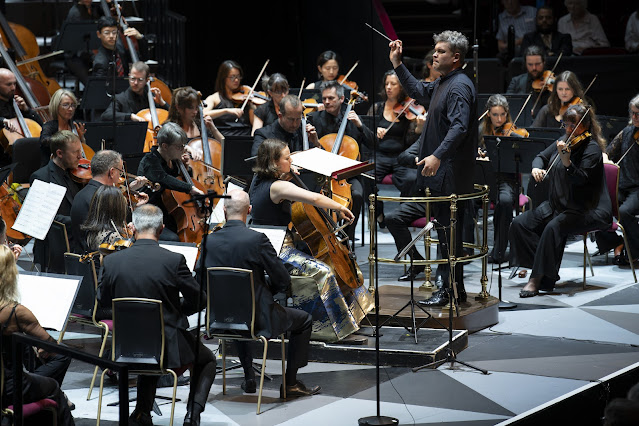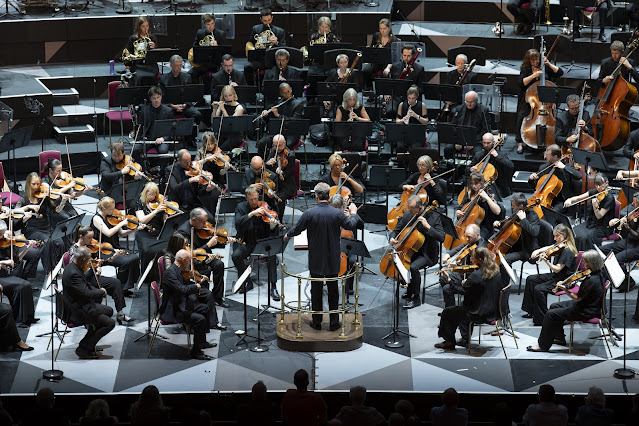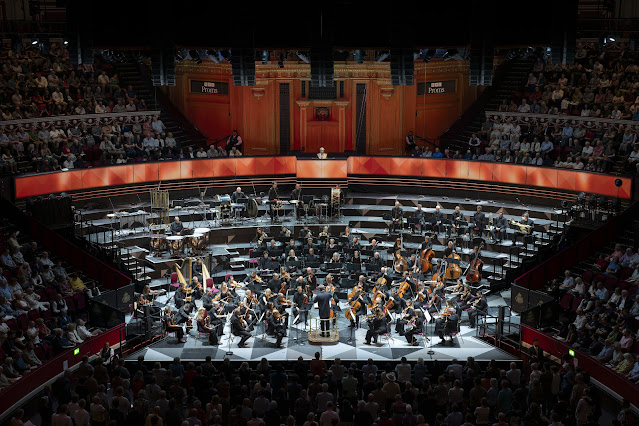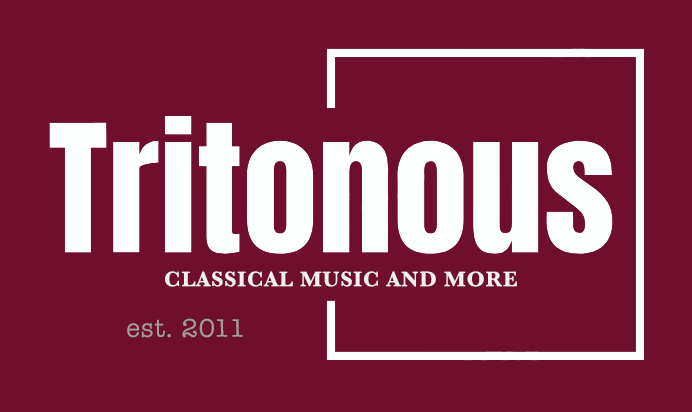 |
| Cheryl Frances Hoad: Cello Concerto ‘Earth, Sea, Air’ – Laura van der Heijden, BBC Scottish Symphony Orchestra, Ryan Wigglesworth – Prom 10 (Photo: BBC / Andy Paradise) |
Britten: Gloriana – symphonic suite, Cheryl Frances Hoad: Cello Concerto ‘Earth, Sea, Air’, Elgar: Symphony No. 2; Laura van der Heijden, BBC Scottish Symphony Orchestra, Ryan Wigglesworth; BBC Proms at the Royal Albert Hall
Reviewed 26 July 2024
The vivid colours and drama of Cheryl Frances Hoad’s new cello concerto at the centre of a programme moving from the vividness of Britten’s Gloriana to the thoughtful poetry of Elgar’s second symphony
Ryan Wigglesworth and the BBC Scottish Symphony Orchestra‘s first BBC Prom at the Royal Albert Hall this year was a programme of German late-Romanticism, with Brahms, Schoenberg and Mahler. For their second visit, on Friday 26 July 2024, Wigglesworth and the BBC Scottish Symphony Orchestra turned to 20th-century English music. The centrepiece of the concert was the first performance at the BBC Proms of Cheryl Frances Hoad‘s Cello Concerto ‘Earth, Sea, Air’ with soloist Laura van der Heijden, a work Wigglesworth commissioned and the same performers premiered in 2022. Around this was assembled a pair of complementary, contrasting works, Britten’s Gloriana – symphonic suite and Elgar’s Symphony No. 2 in E flat major.
Britten’s Gloriana, despite the great success of modern productions, remains haunted by the muted reaction to the premiere. It is not a perfect work, and suffers from Britten’s decision to put it on one side rather than revise it, but the symphonic suite rescues four of the major moments in the work. The Tournament opened things with vivid brilliance and strong rhythms, plus a strong sense of expectation yet it ended on a questioning, intimate note with solo violin. The Lute Song recycles Essex’s lovely solo, a melody that is important throughout the opera. Here the solo is on the oboe and what we had was hushed magic, the strings setting of the clear beauty of the oboe solo, far more aetherial than the operatic original. The third movement features the Courtly Dances that are from the third act, six short, highly coloured moments, with engagingly crisp rhythms, nicely delineated characters. The movement brilliantly encapsulated a certain 20th-century style of writing ‘ancient’ music. The final movement, Gloriana moritura is adapted from the opera’s ending and is far less of a number than the others, much more symphonic in style. Beginning with same brilliant style as the earlier movements, it became more complex before gradually unwinding.
 |
| Prom 10 – BBC Scottish Symphony Orchestra, Ryan Wigglesworth (Photo: BBC / Andy Paradise) |
Cheryl Frances Hoad’s Cello Concerto ‘Earth, Sea, Air’ came in 2022 at the end of her Visiting Research Fellowship in the Creative Arts at Merton College, Oxford, and the work is imbued with the interactions with other disciplines that the fellowship provided. So, the three movements, Earth, Sea and Air, are not evoking a conceptual view of the elements but take a more scientific bent. Earth is inspired by volcanoes, Sea by the growth of phytoplankton (microscopic marine algae) in the oceans, and Air by the flight of swifts. But, as Frances Hoad says in her programme note, ‘none of this need matter when listening: my concerto is also inspired by Laura’s wonderful playing, her character and my desire to write a piece that is rewarding to play and listen to.‘
After a sharp orchestral gesture, Laura van der Heijden launched into an intense rhapsodic solo and the opening section alternated these two ideas, before developing a soaring, rhapsodic cello line over orchestral gestures, full of colour and movement. The focus was very much on the soloist, though there were more explosive passages where van der Heijden’s playing was inaudible but Frances Hoad seemed to relish the way the solo line would emerge alone from noisy demonstrations. Perhaps a sense of the lone traveller against the might of the volcano. The second movement featured a thoughtful solo line over quiet but rich orchestral harmonies with lots of moving parts, full of colour and texture. An eerie passage where van der Heijden played over sustained strings and tuned percussion was pure magic, but the ending featured an increase in intensity and virtuosity. The solo line in the third movement, Air, started out as rather winsome, contrasting with rather jazzy elements in the orchestra, with tuned percussion to the fore again. A busy and vivid solo line developed over an orchestra full of colour and movement, leading to a strikingly sudden ending.
The work provides three highly contrasting movements, making for a satisfying piece which features a vivid solo part. Laura van der Heijden was tireless in her playing of a solo line that was near constant, strenuous at times, highly virtuosic and soaring, she encapsulated everything. A very full Albert Hall gave an enthusiastic reception to the work and we were rewarded with an encore, Casals’ Song of the Birds.
After the interval we turned back the clock to 1909-11 for Elgar’s Symphony No. 2, a highly personal work that has little of the swagger and confidence of his earlier symphony and which commentators have discussed endlessly. That the work might be an elegy for the Edwardian age is certainly possible, but in Wigglesworth’s hands the work’s sense of phantasmagoria was high, and I thought of RVW, when discussing the final movement of his Symphony No. 6 quoting Shakespeare, ‘We are such stuff as dreams are made on’.
We began with confidence, the impetuous nature of the first movement’s first theme to the fore, the phrases almost running over each other and with Wigglesworth keeping the work in constant motion, yet the second theme was poised and flowing with moments of real intimacy. The central development moved from the vivid and vigorous towards the intimate and tender, and there was a real liquid quality to even the slower moments. Well before the return of the first theme, Wigglesworth and the players developed a real sense of anticipation. The return of the material was perhaps steadier. The long Larghetto is seen as something of a funeral march. Here the opening was pure magic, leading to music that was sombre, yet still fluid and flowing, There was a flexibility and transparency to the phrasing, but the onward movement felt questing. There were moments of great tenderness, but also that sense of phantasmagoria, was this a funeral march or a farewell to ghosts of the past? The Rondo felt a lot lest scherzo-ish than usual, beginning light and characterful, yet rather pointed, this alternated with more strong and impulsive movements, yet the middle was mysterious and highly mobile, when the more vigorous material returned it quickly evaporated, the music seemed haunted by the same ghosts as the first movement. The final movement began with the glorious horn melody over orchestral textures that were full of impulsive details, yet as the movement developed there was the feeling that the material was composed of fragments that never quite came together. The exhilaration of the return of the opening material was short lived, evaporating into phantasmagoria again as the music moved to almost nothing.
 |
| Prom 10 – BBC Scottish Symphony Orchestra, Ryan Wigglesworth (Photo: BBC / Andy Paradise) |
This was a remarkable performance, one that kept the work flowing yet never felt rushed and which brought out the remarkable detail of Elgar’s orchestral writing, yet never got bogged down. I loved Wigglesworth’s willingness to present the music as he sees. This was a thoughtful and poetic conclusion to a remarkably balance and imaginative programme.
Never miss out on future posts by following us
The blog is free, but I’d be delighted if you were to show your appreciation by buying me a coffee.
Elsewhere on this blog
- She played and sang: Gillian Dooley’s new book is the fruit of 15 years research on Jane Austen’s music collection – interview
- A world away from the Bibilical oratorio: Stanford’s Whitman setting is the focus for this disc of two of large-scale choral works – record review
- A vividly realised recording: rediscovering music by Latvian-American composer Gundaris Pone – record review
- Returning to Northern Ireland Opera for his third role, British-Ukrainian baritone Yuriy Yurchuk on Tchaikovsky’s Eugene Onegin – interview
- Relentlessly entertaining: Handel’s Acis and Galatea at Opera Holland Park rather over-eggs things but features finely engaging soloists – opera review
- Contemporary contrasts: Wolf-Ferrari’s Il segreto di Susanna & Leoncavallo’s Pagliacci in a satisfying double bill at Opera Holland Park – opera review
- A sound world that is distinctive, appealing & engaging: Maria Faust’s Mass of Mary on Estonian Record Productions – record review
- A rich sophistication of thought running through this programme that seems worlds away from the typical debut recital: Awakenings from Laurence Kilsby & Ella O’Neill – record review
- Fine singing and vivid character: a revival of John Cox’s vintage production of Mozart’s Le nozze di Figaro at Garsington – opera review
- An intuitive abstract Sudoku working with sound parameters and with no single solution: Chilean composer Aníbal Vidal on writing music – interview
- Youth, experience and a warm reception: our visit to the Glasperlenspiel Festival in Tartu, Estonia – concert review
- Home


.jpg?w=998&resize=998,665&ssl=1)




